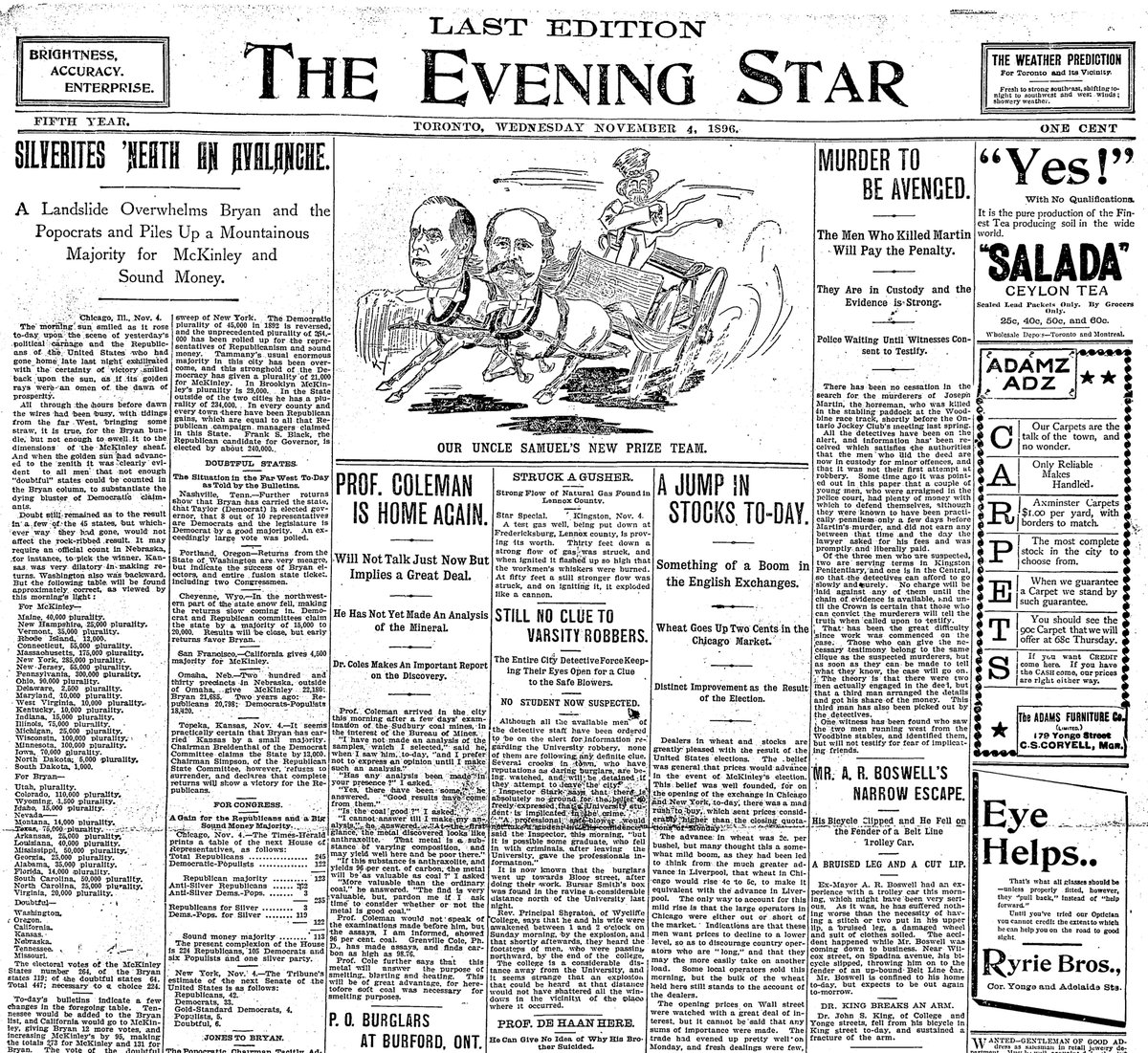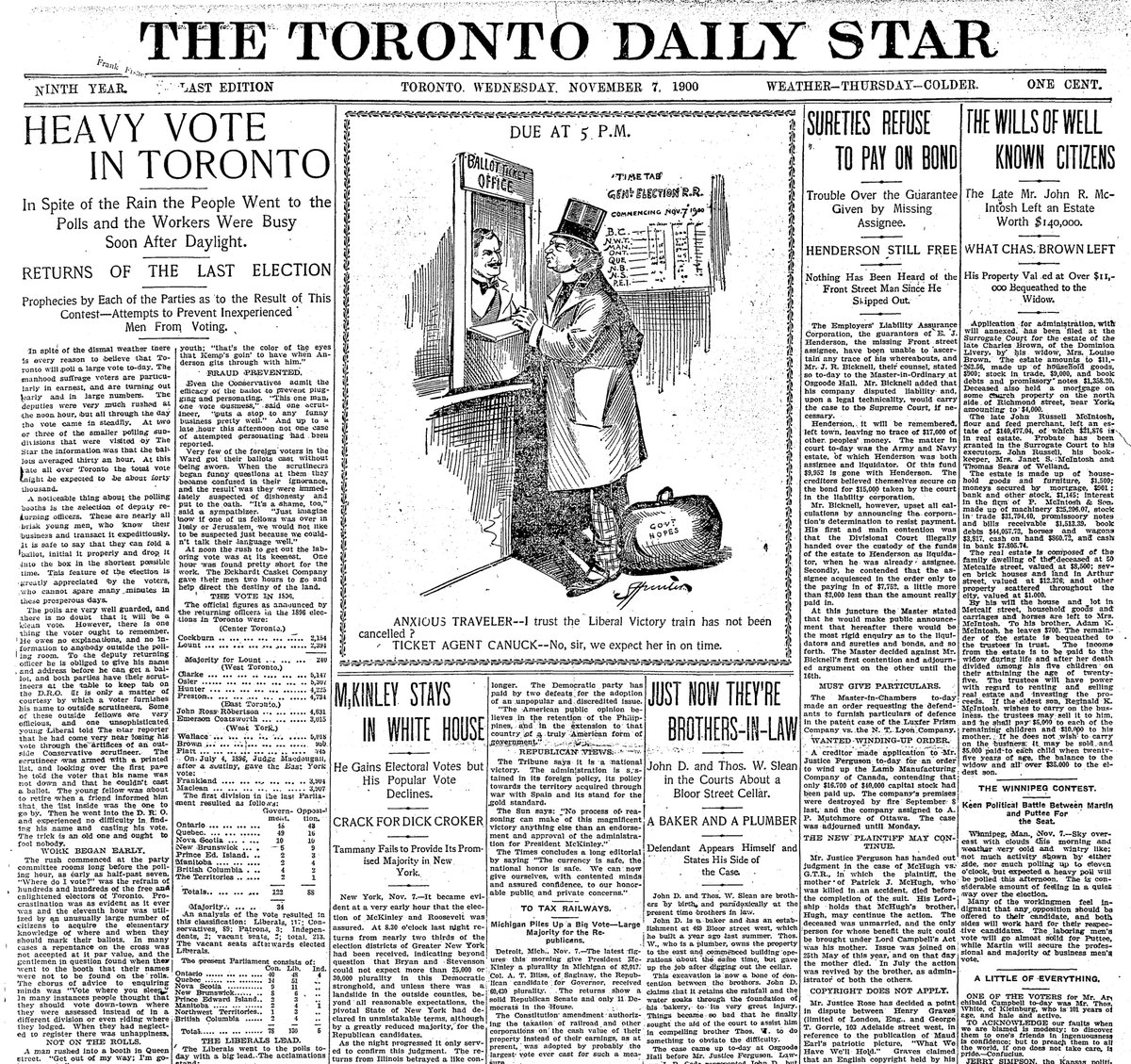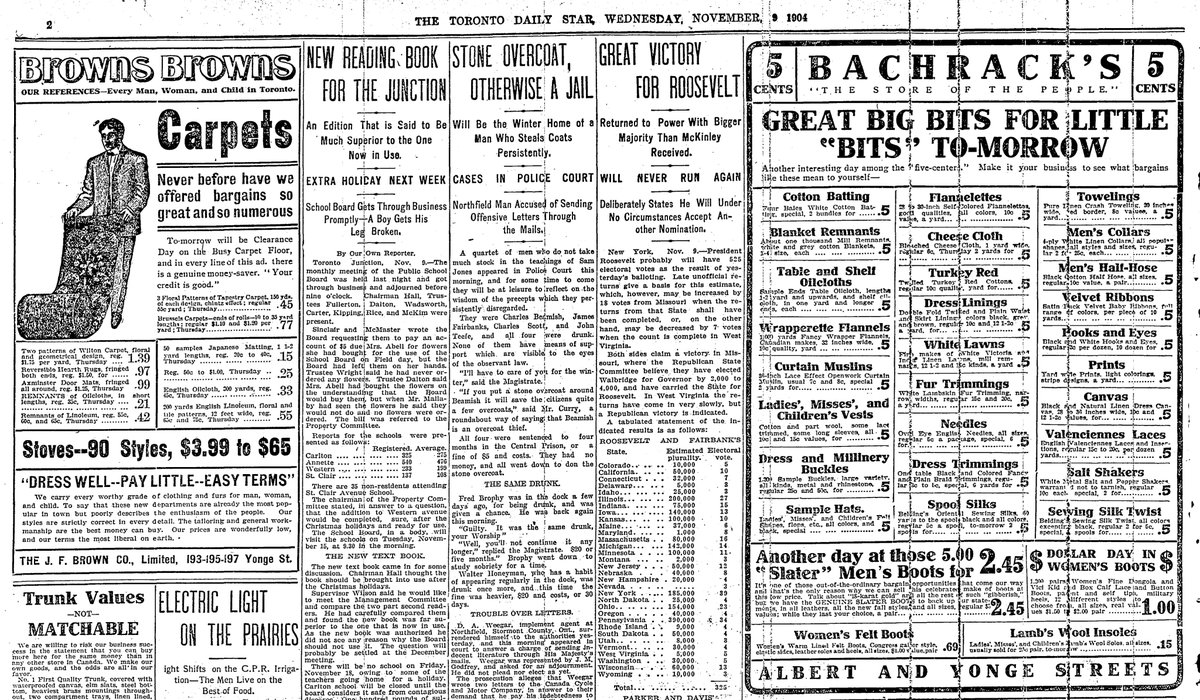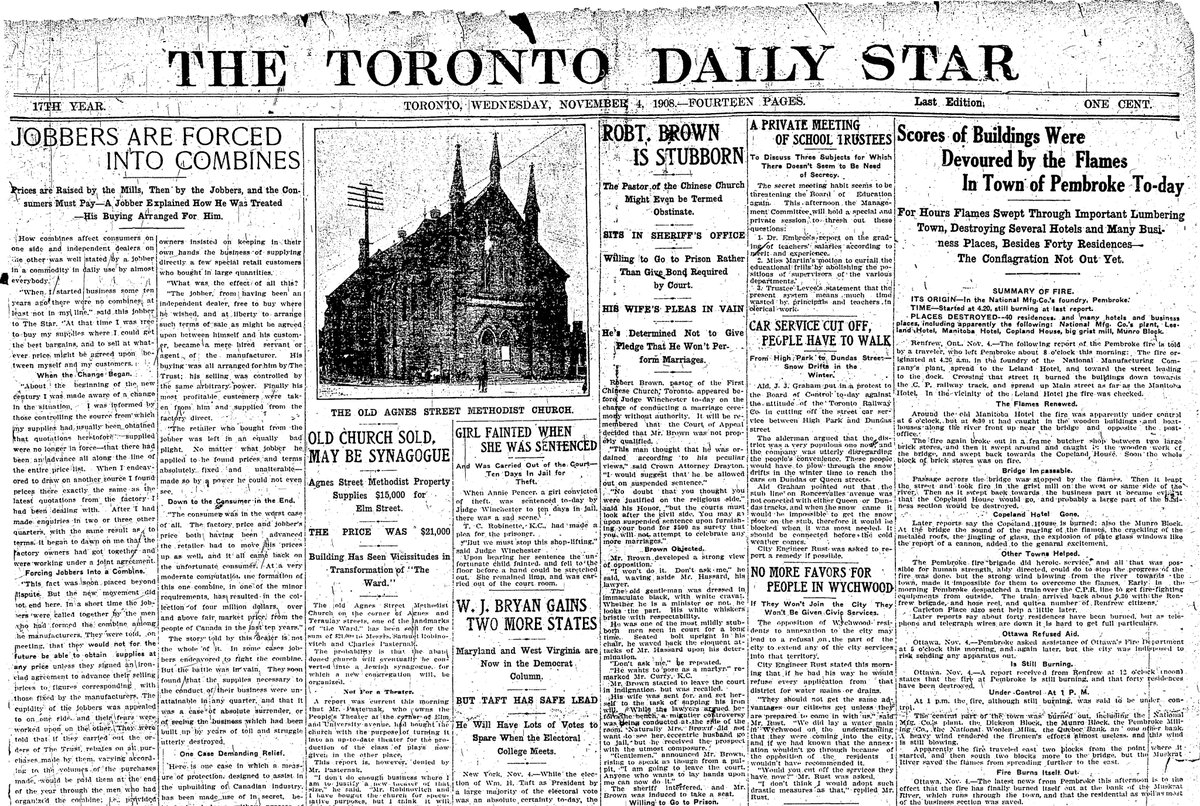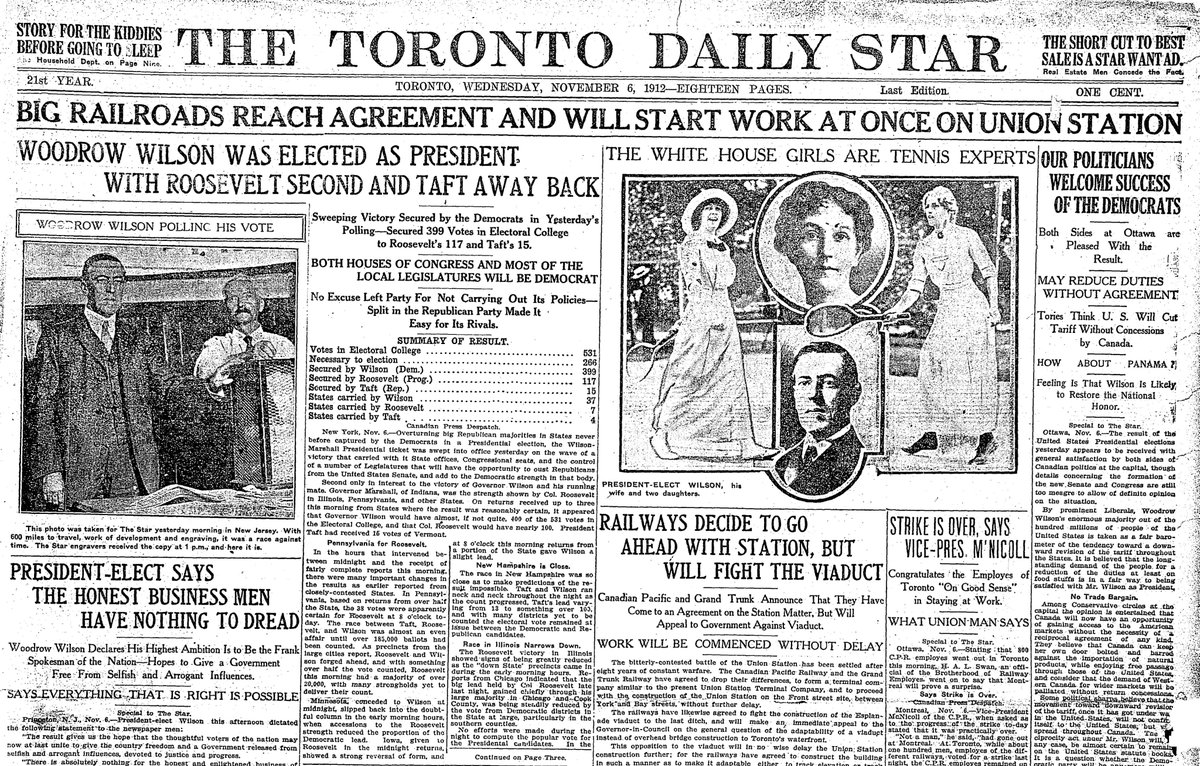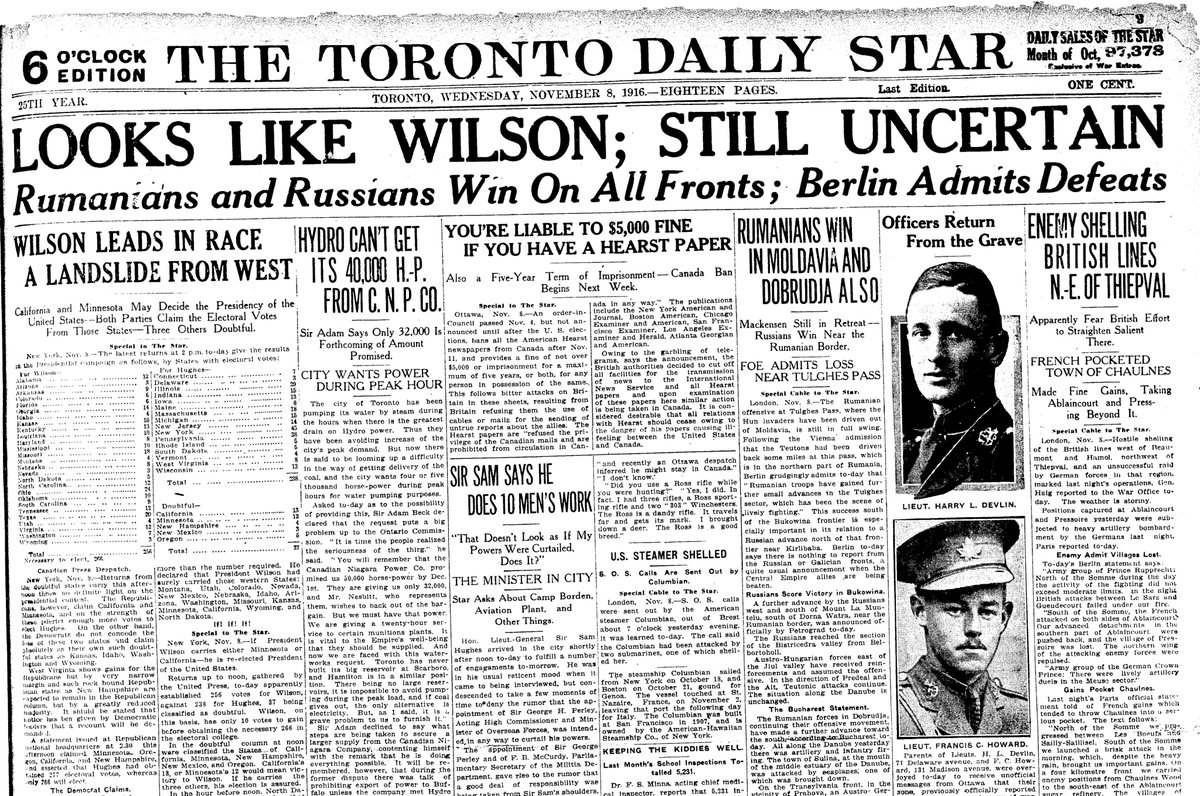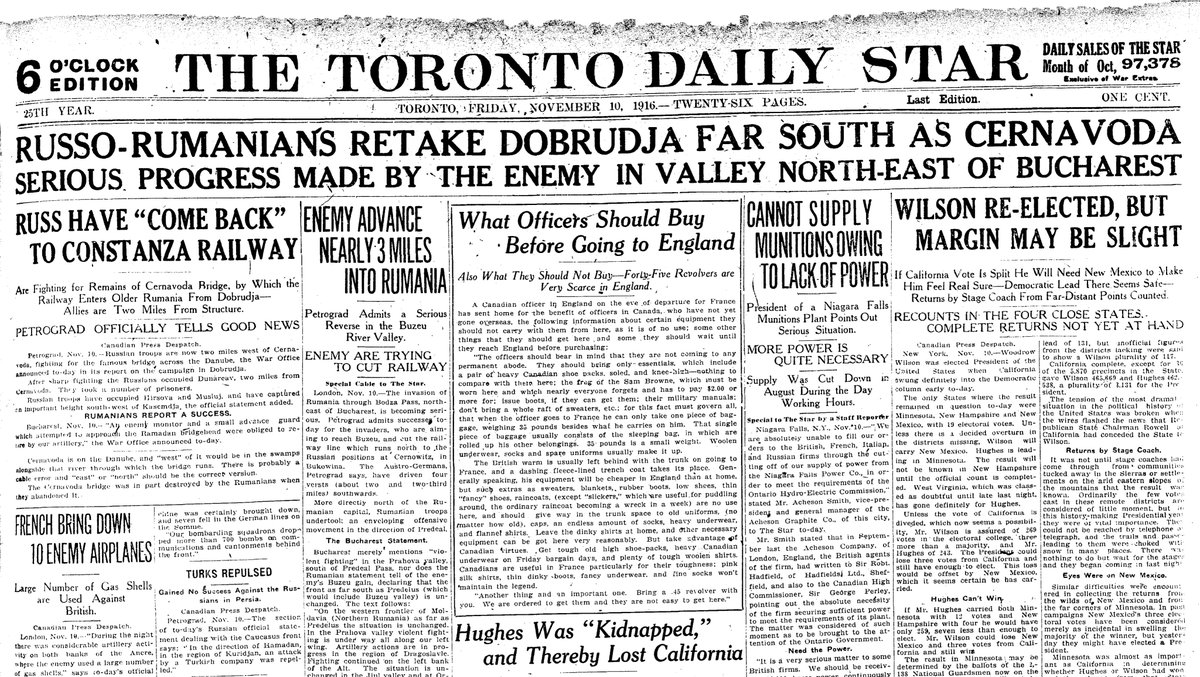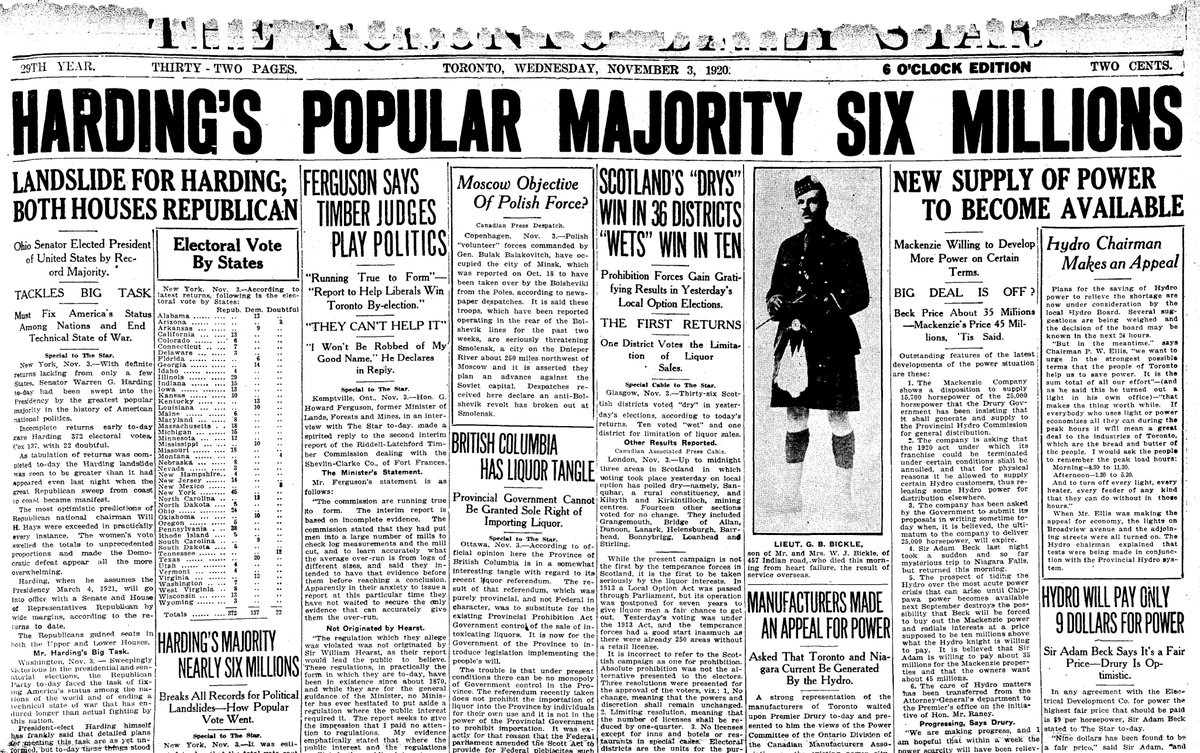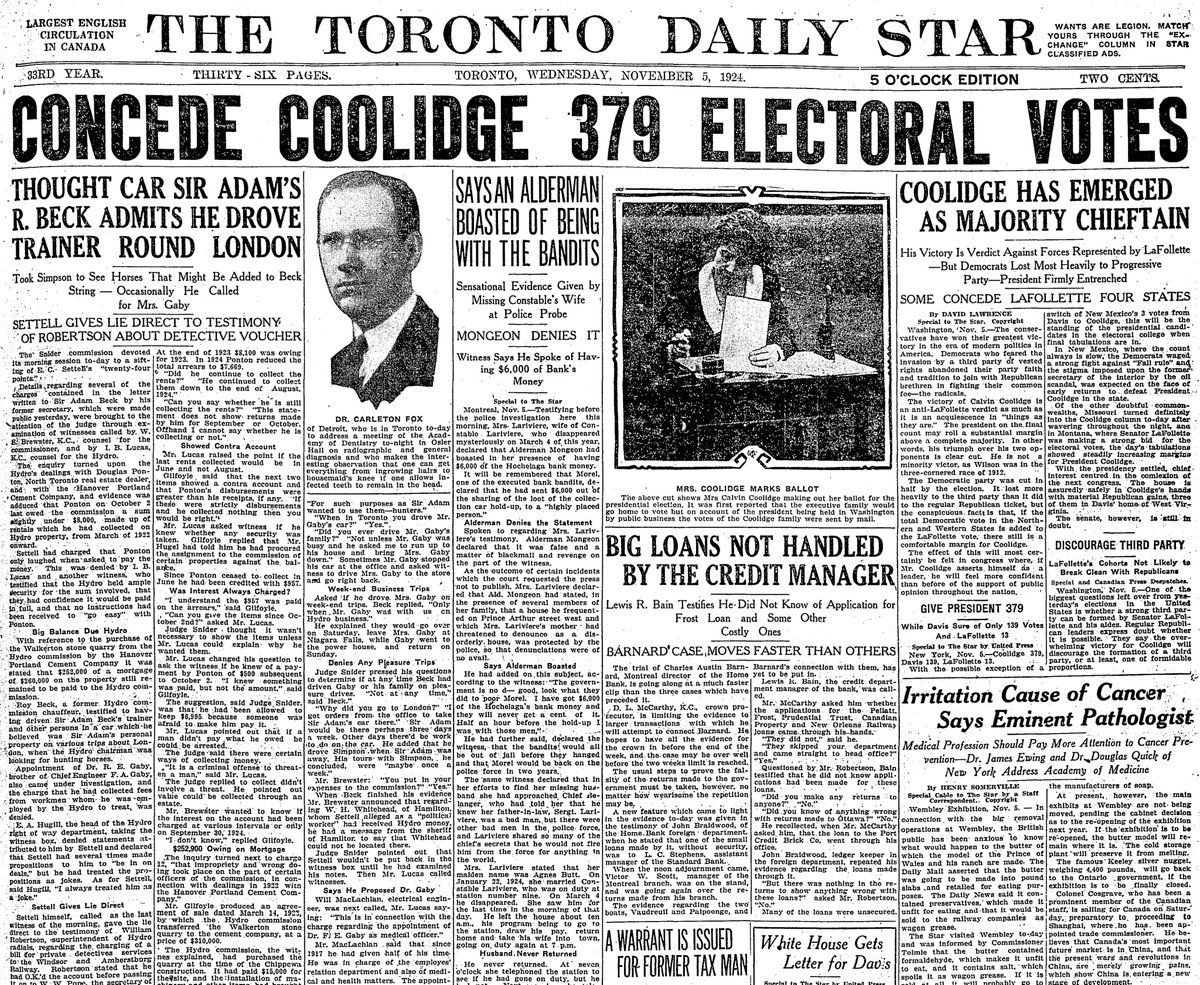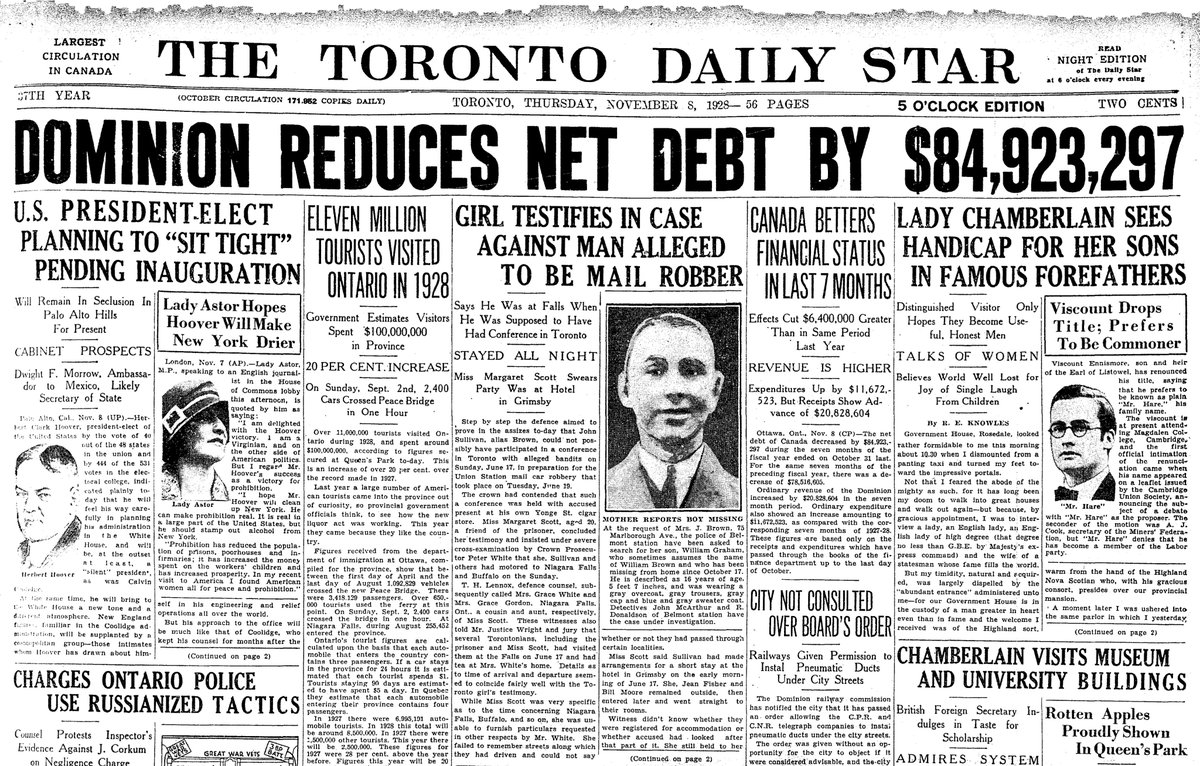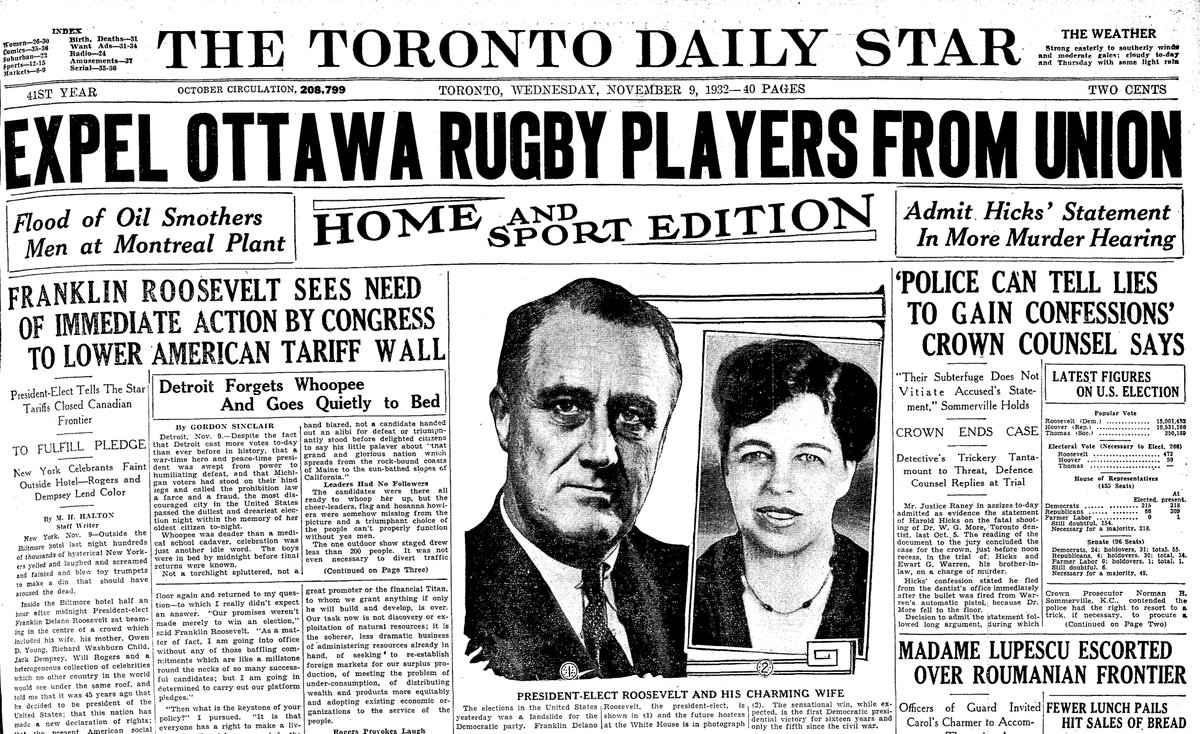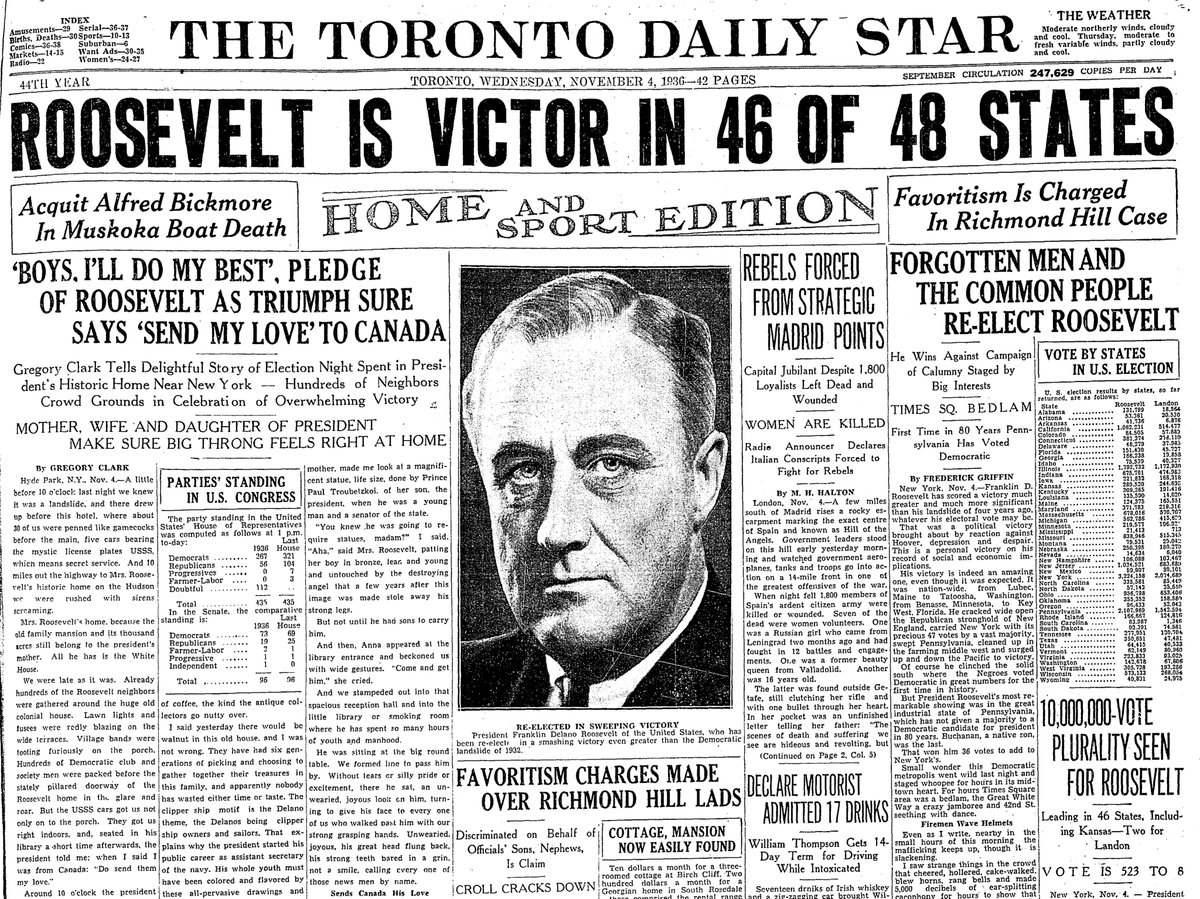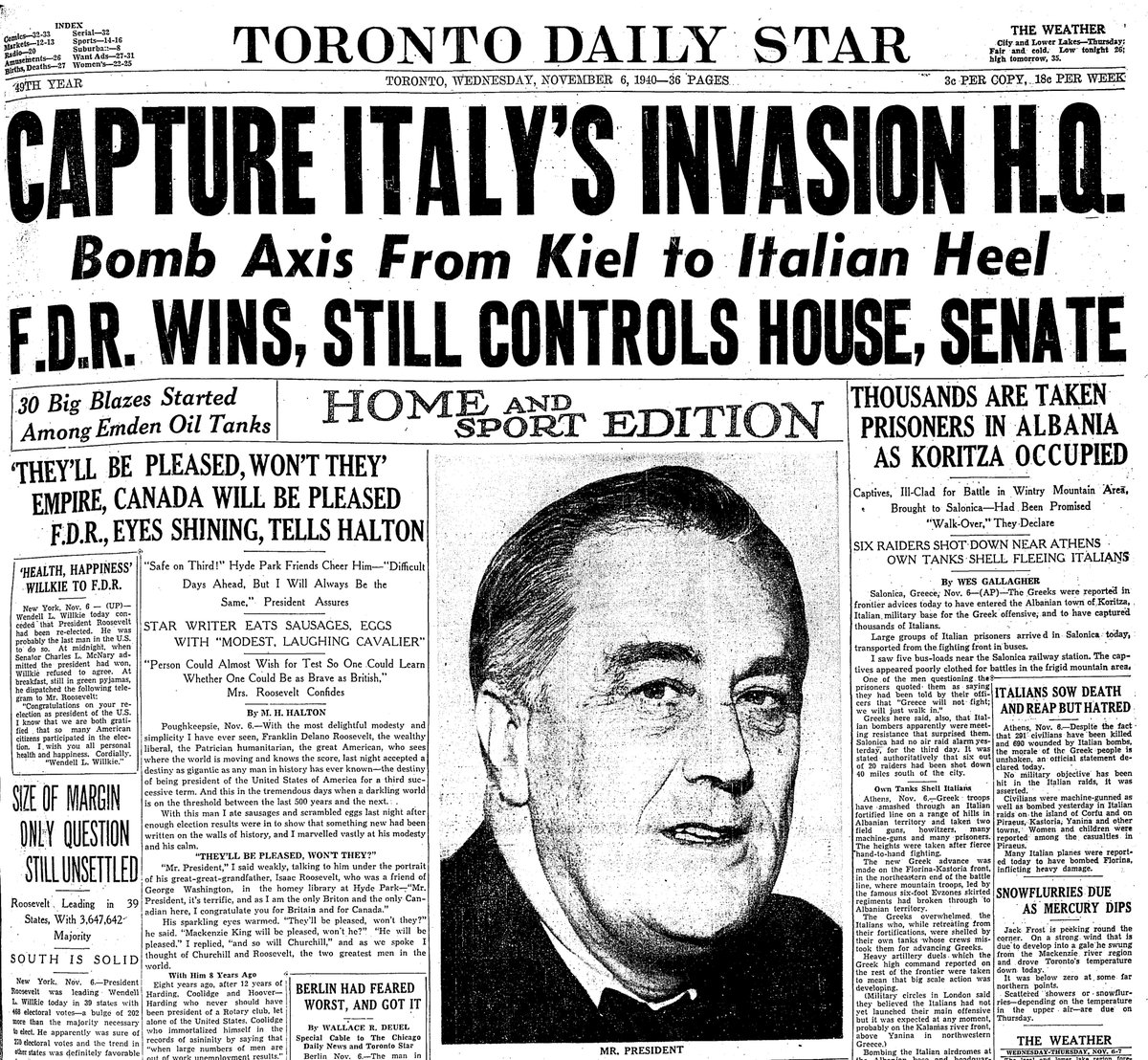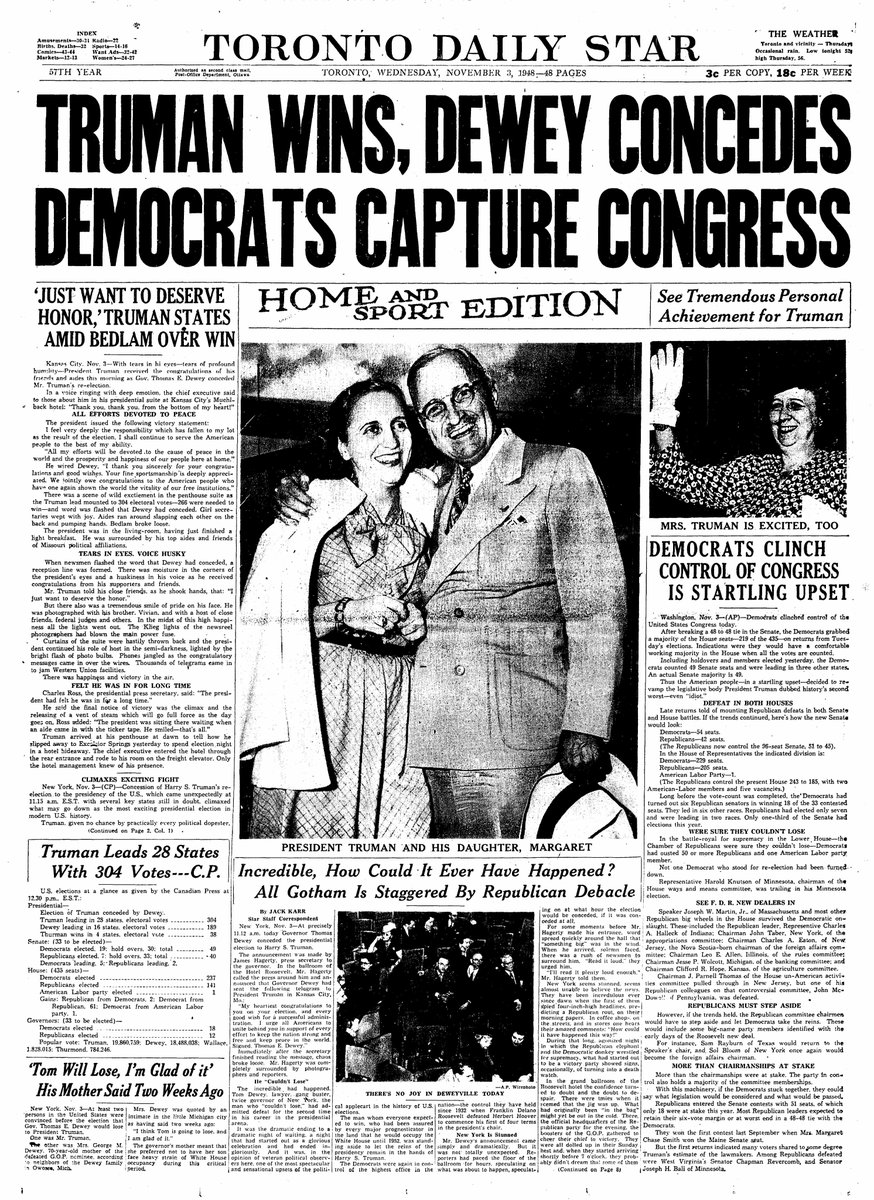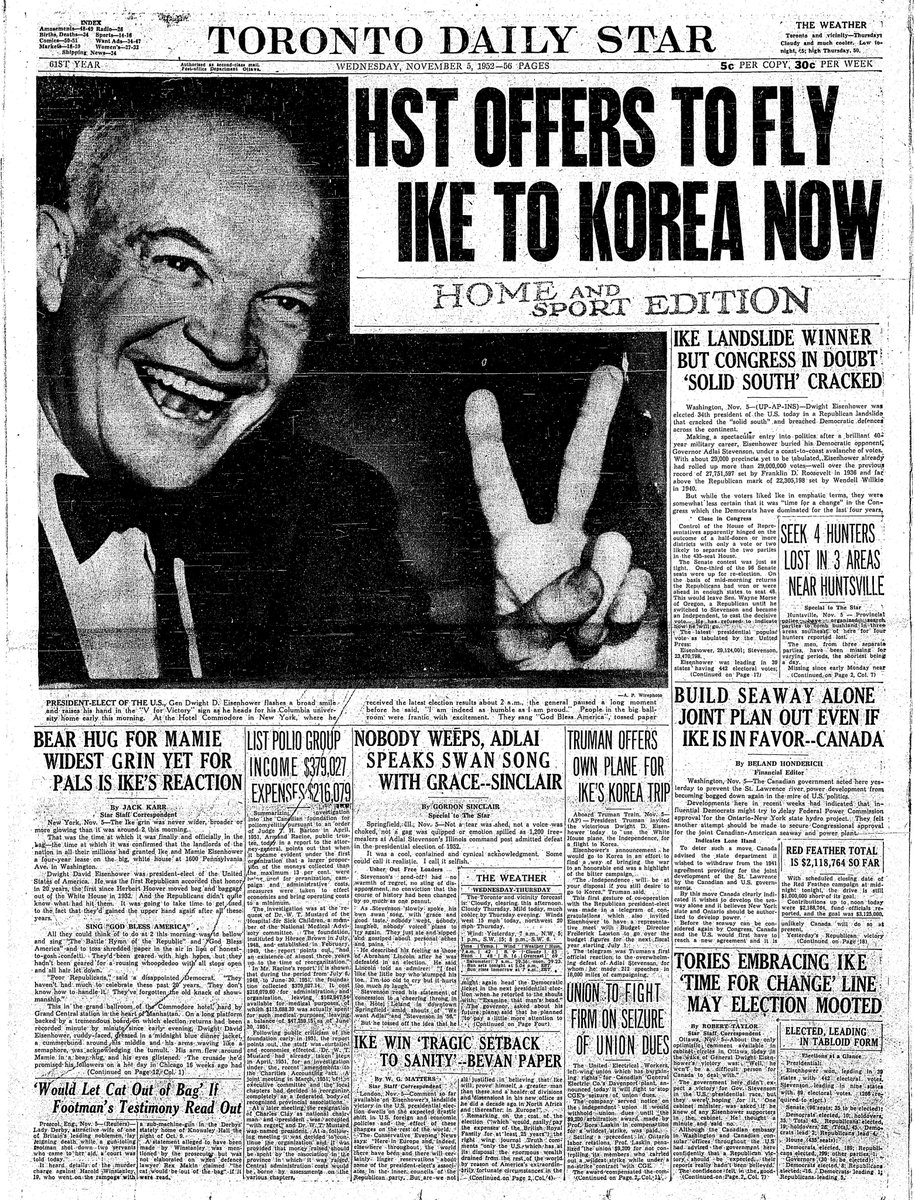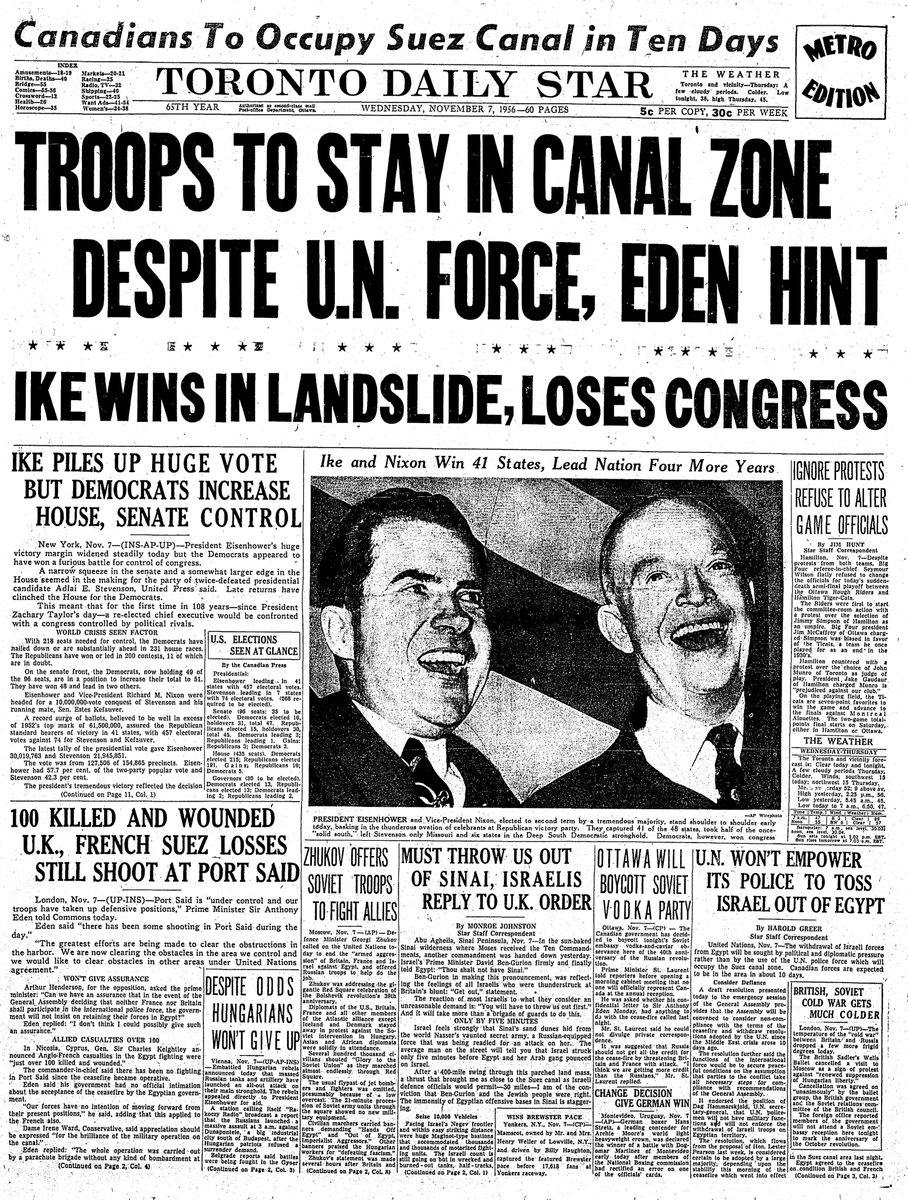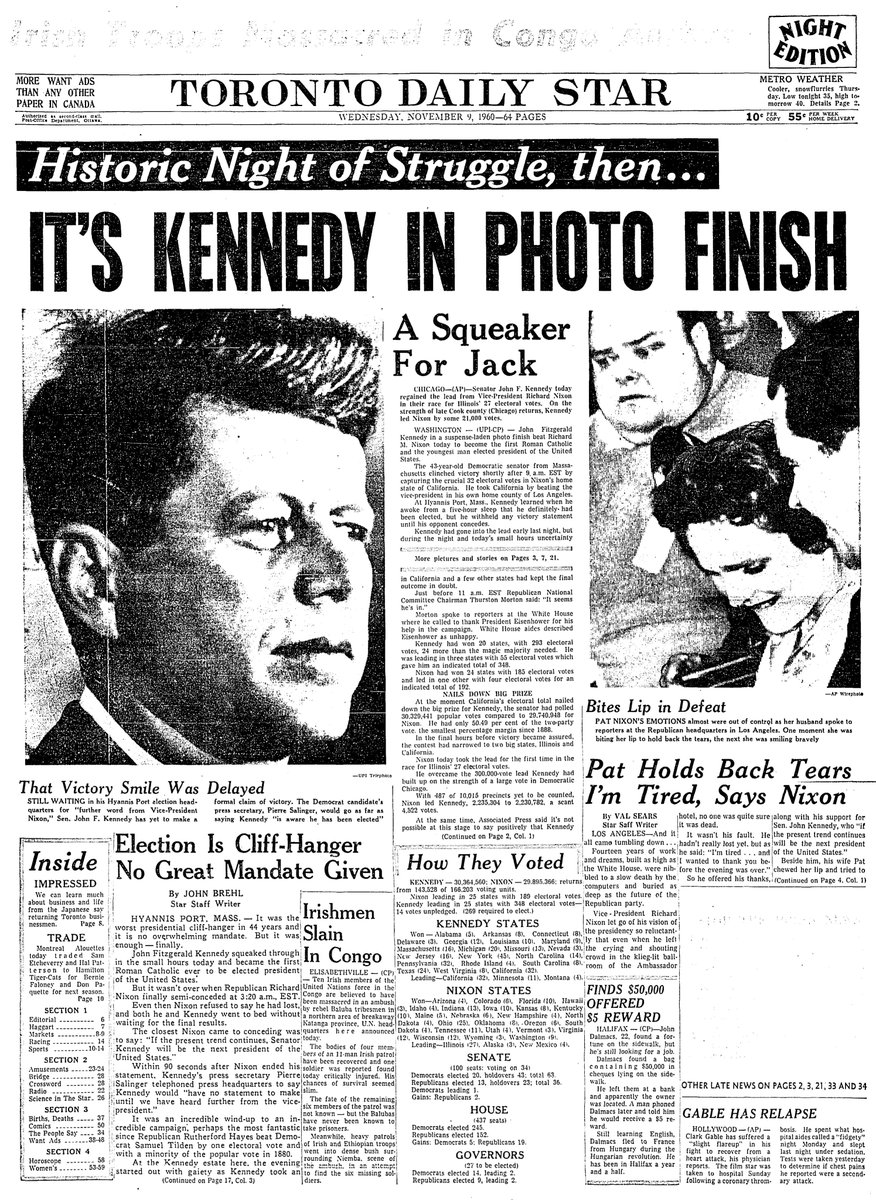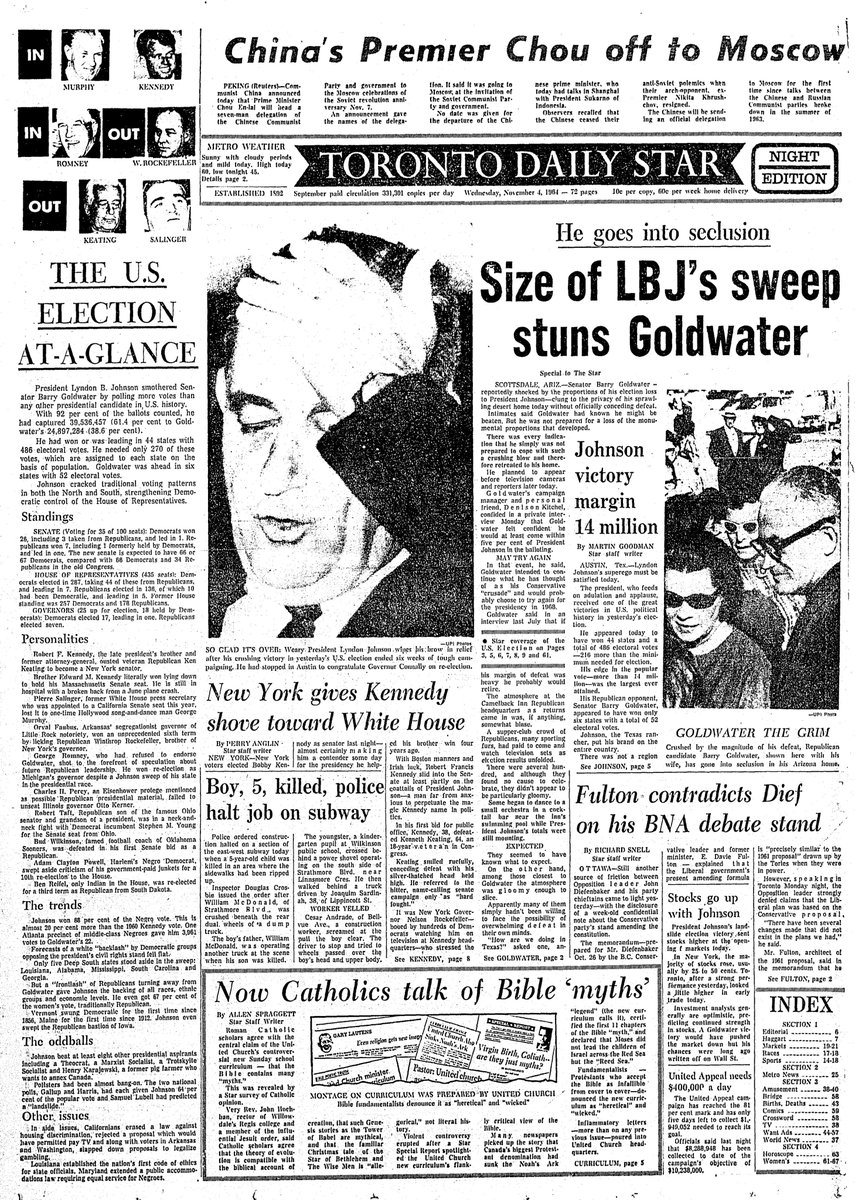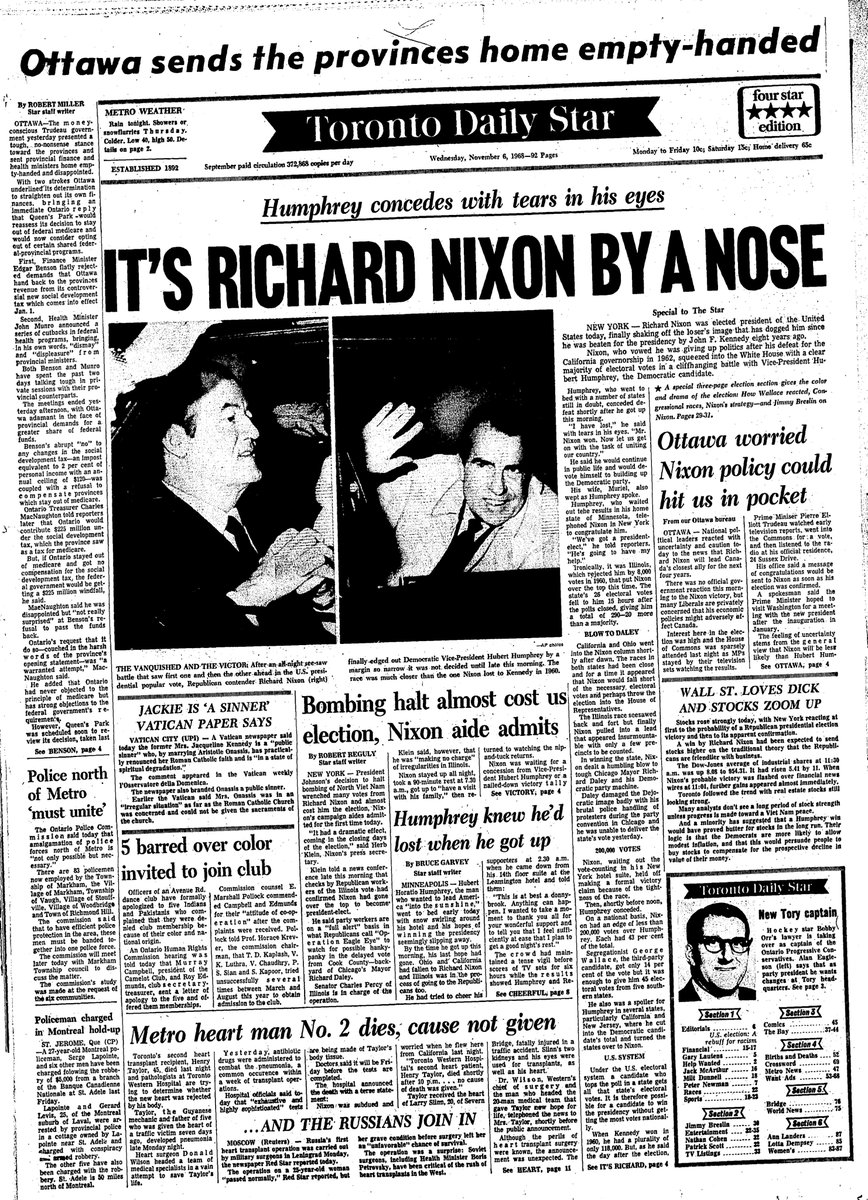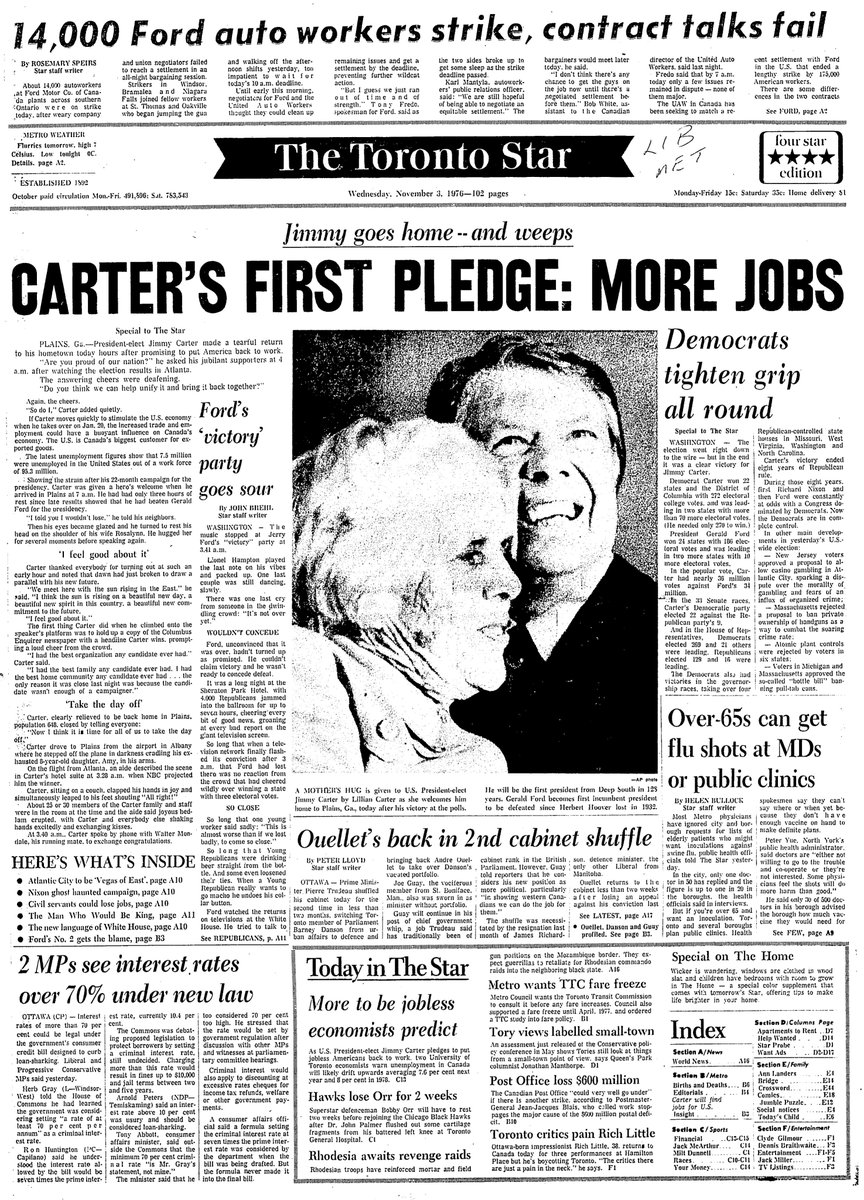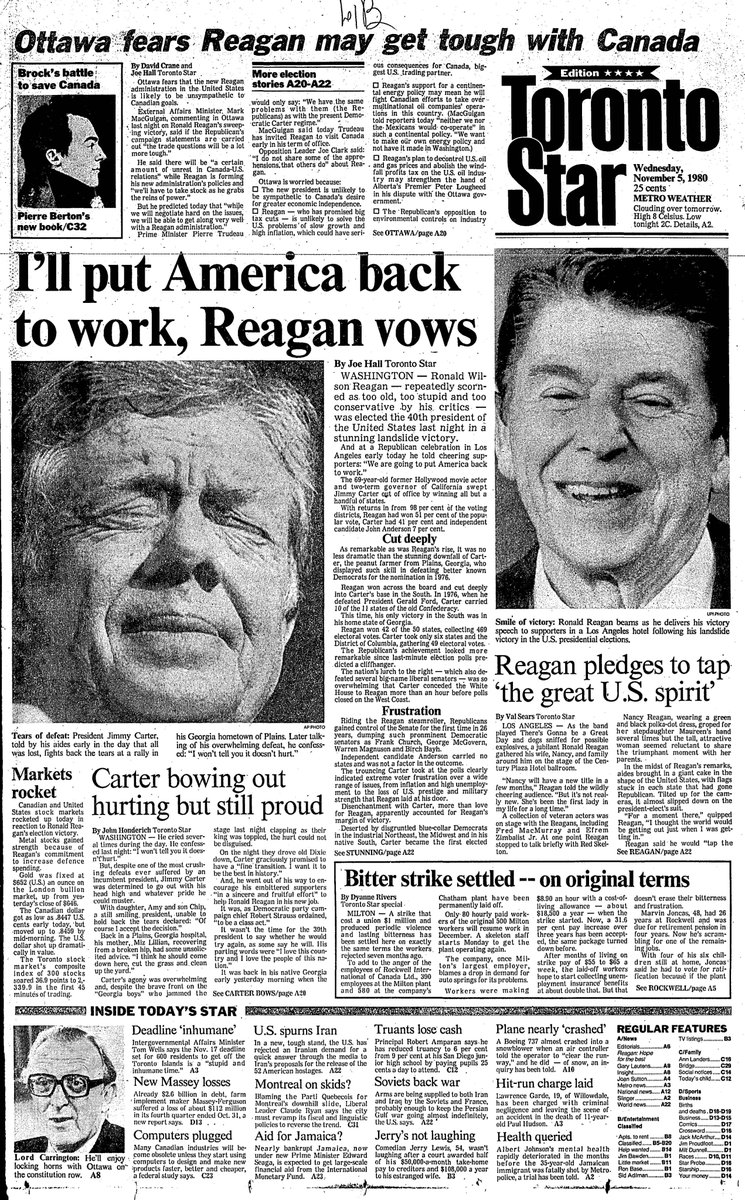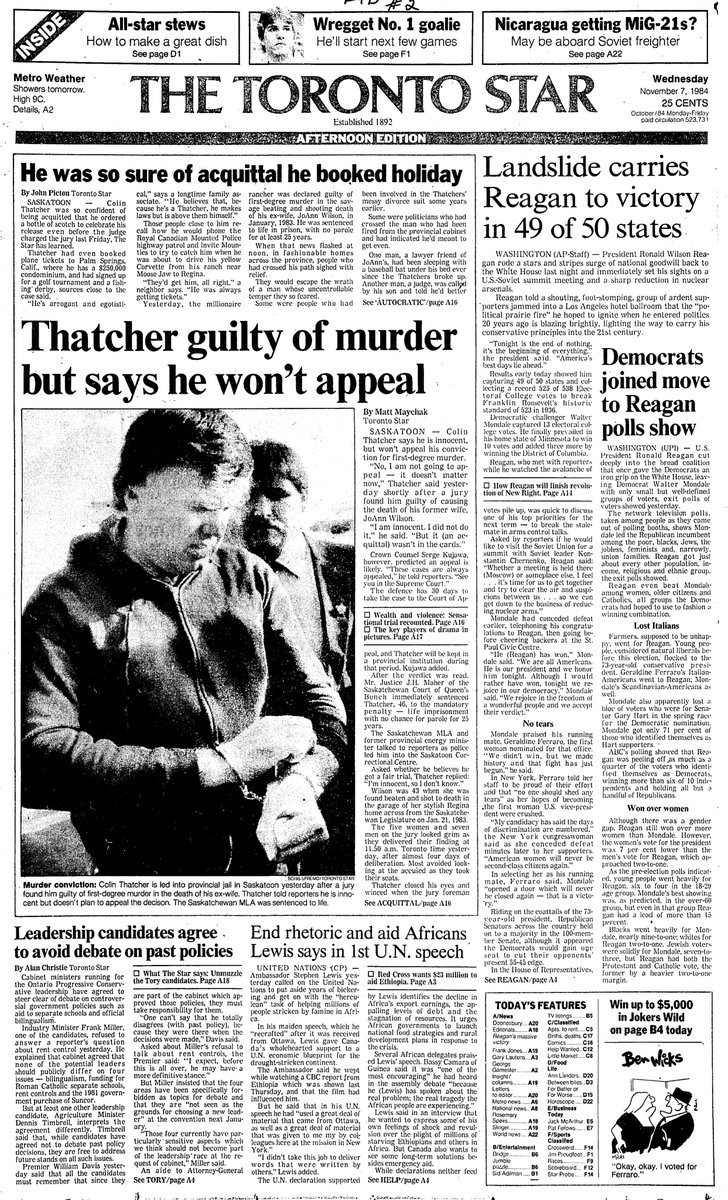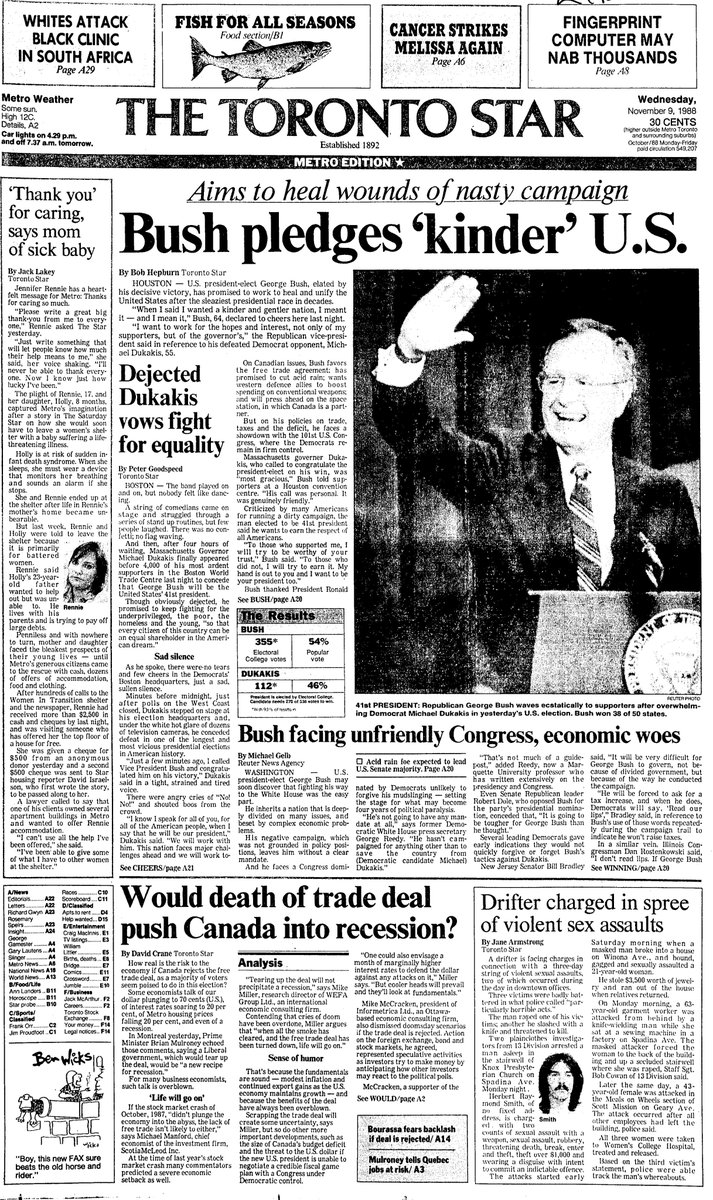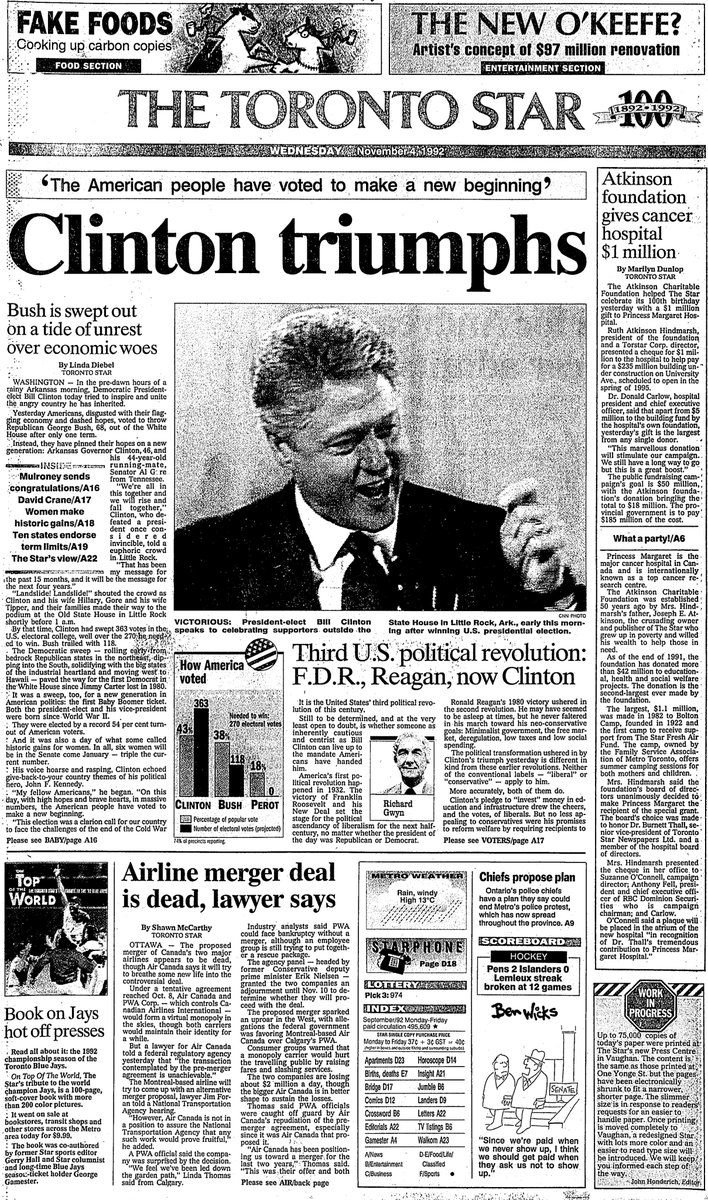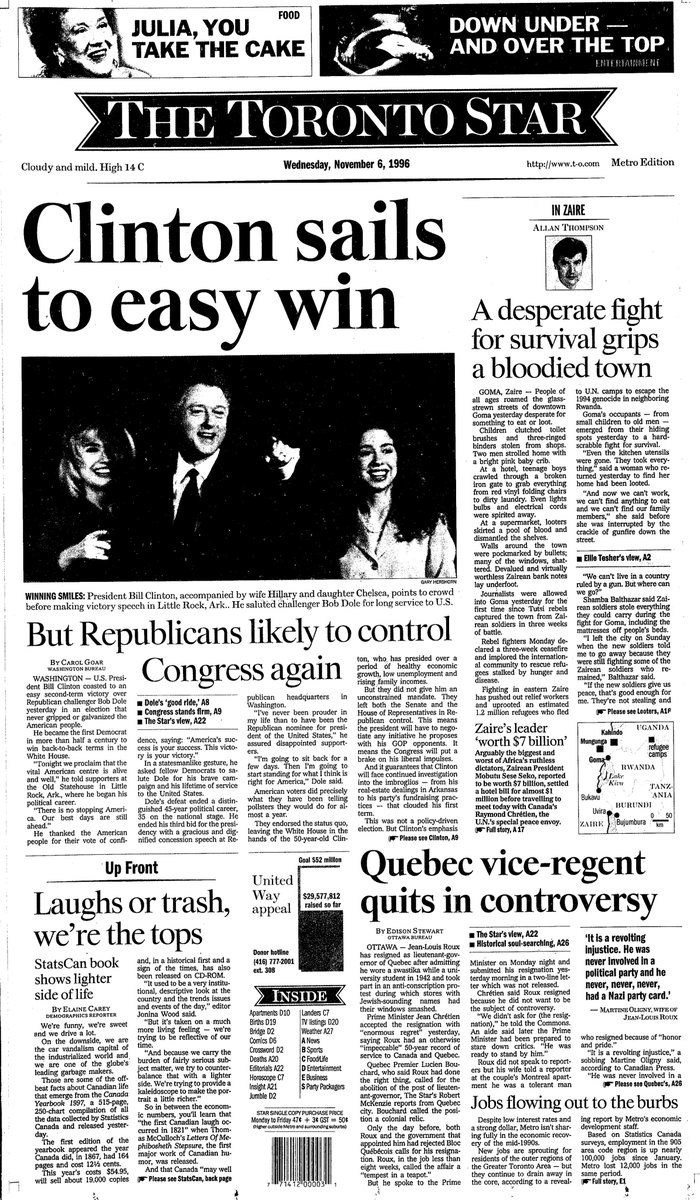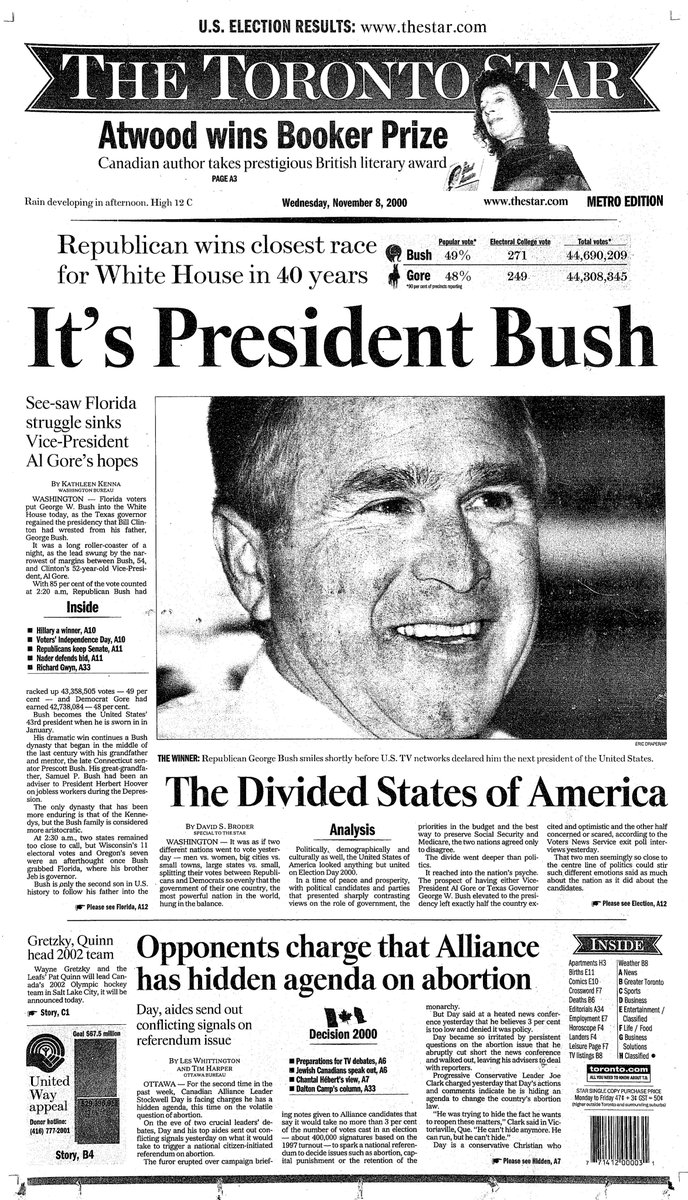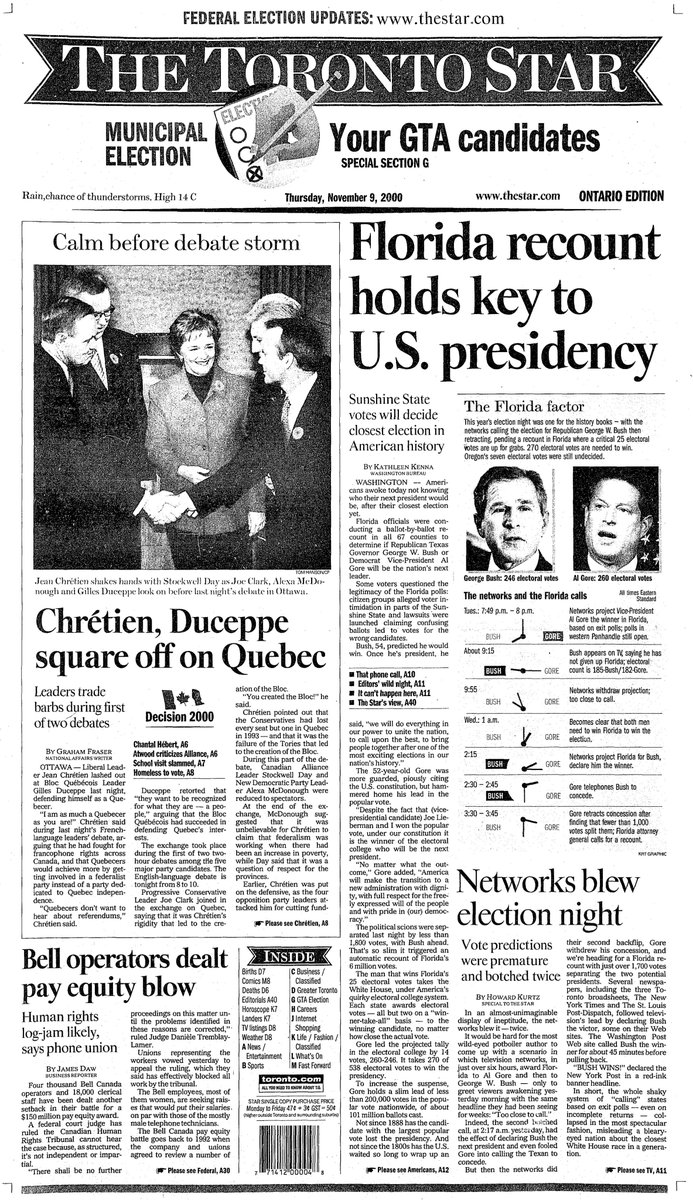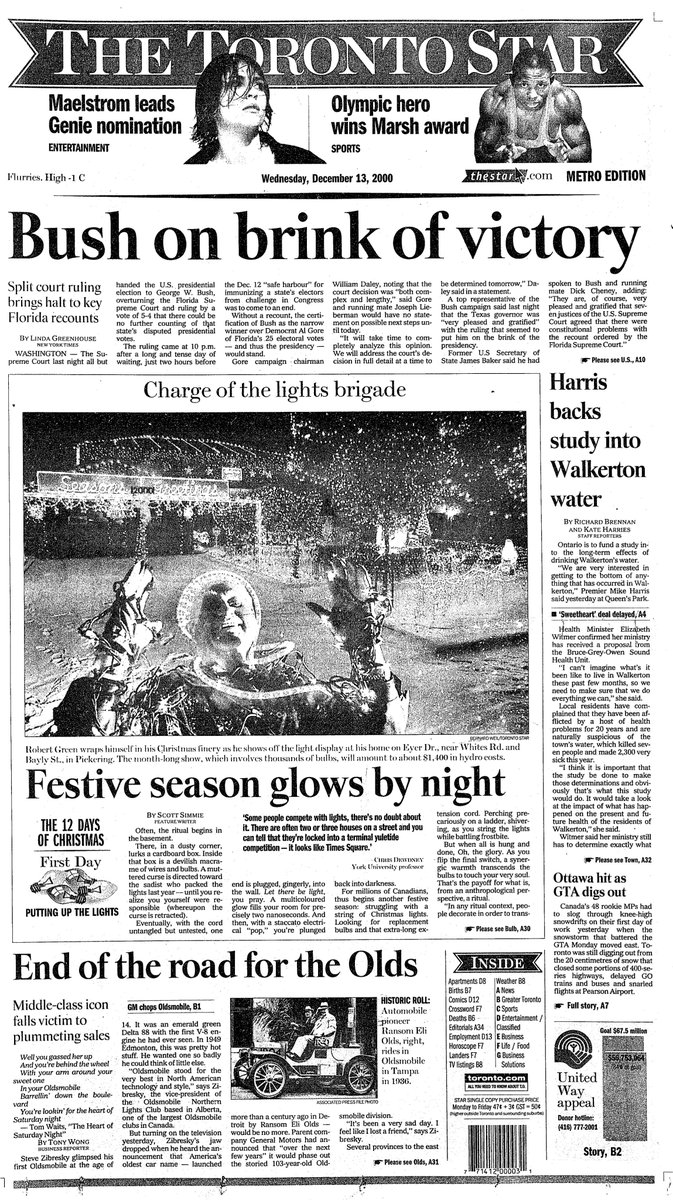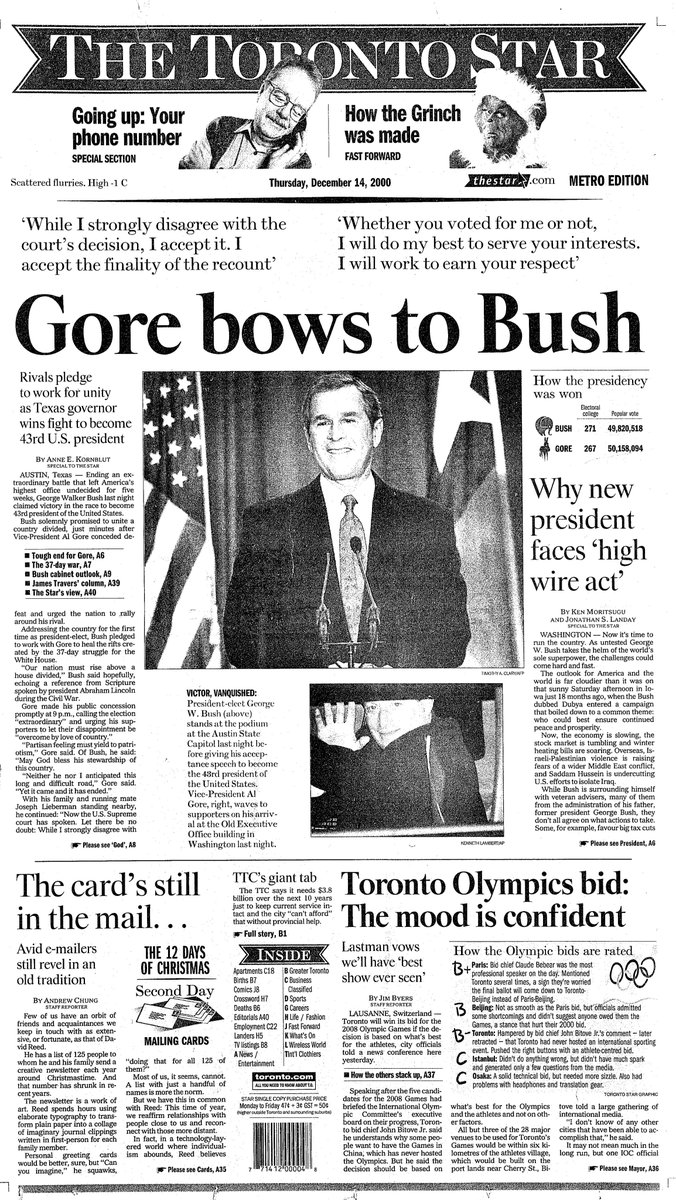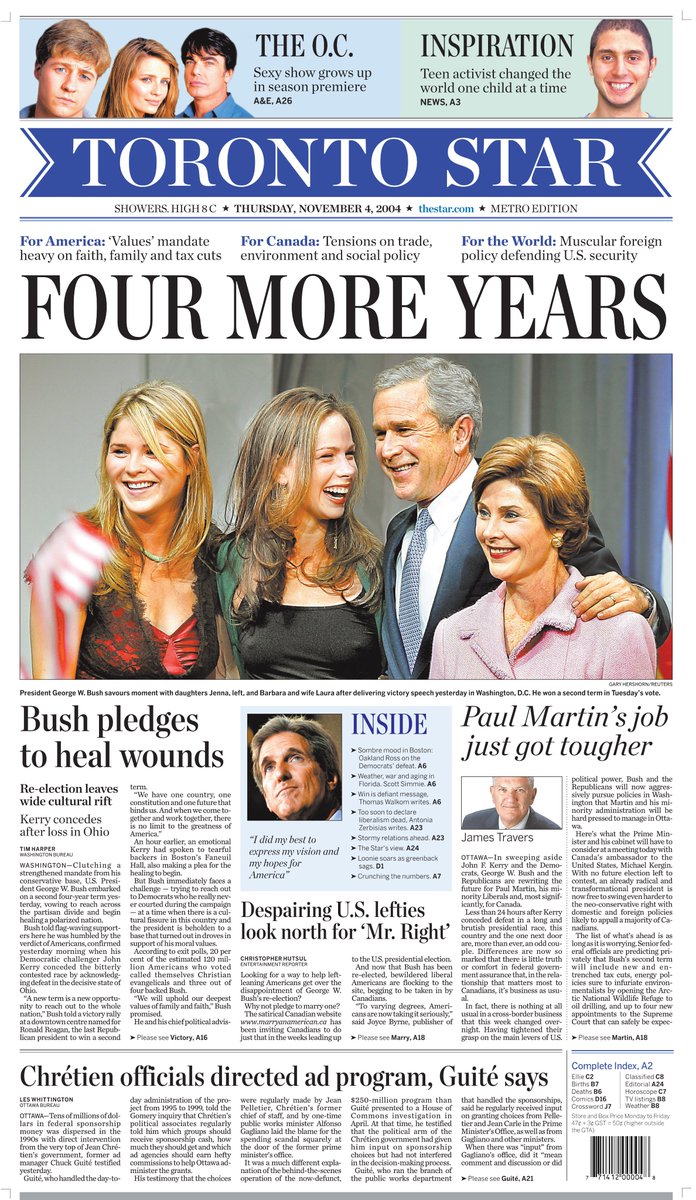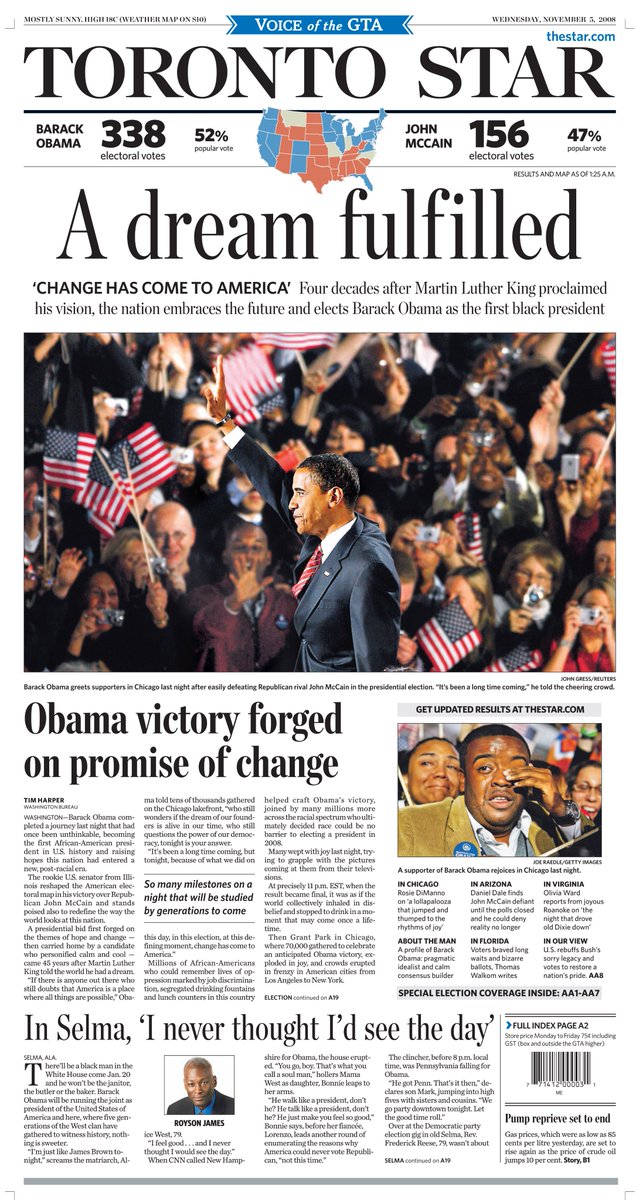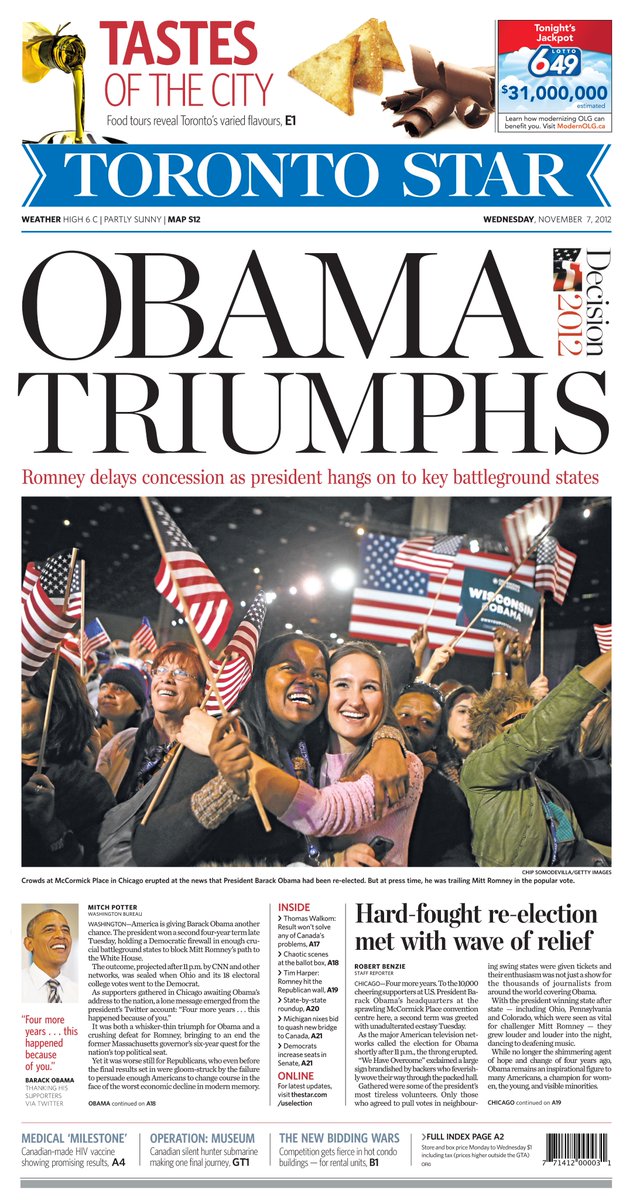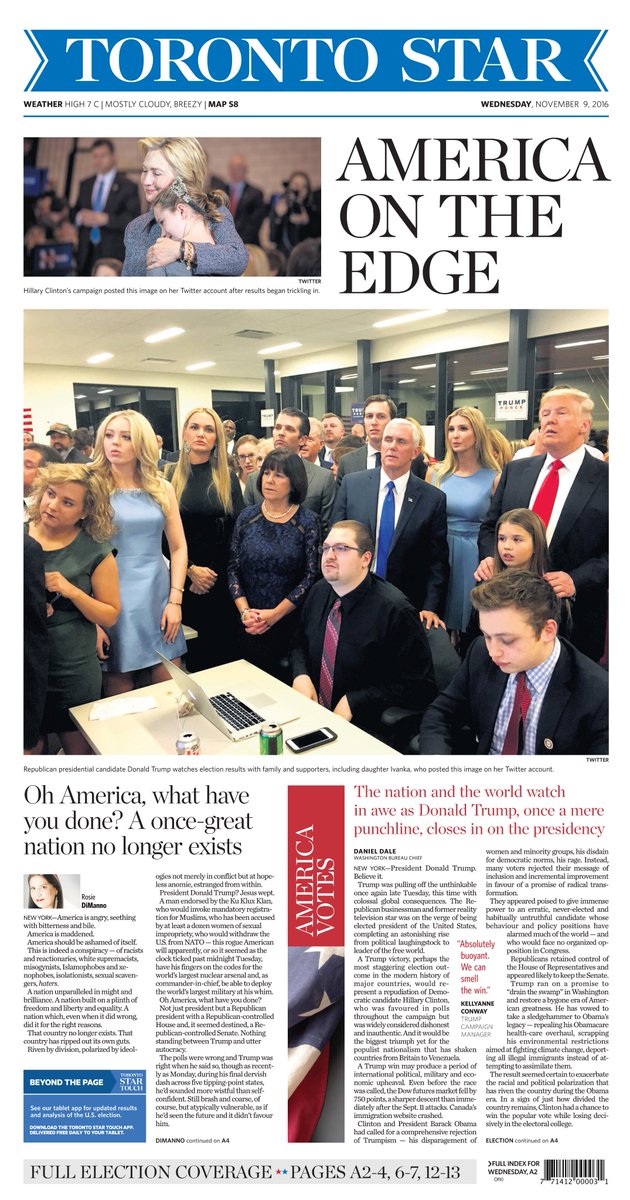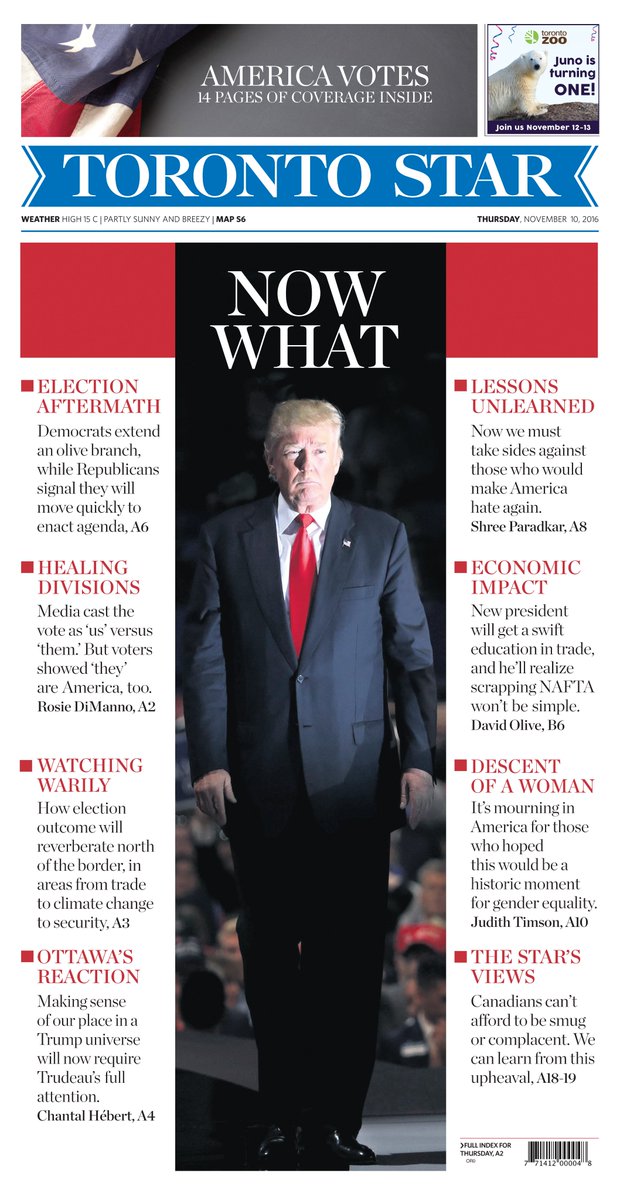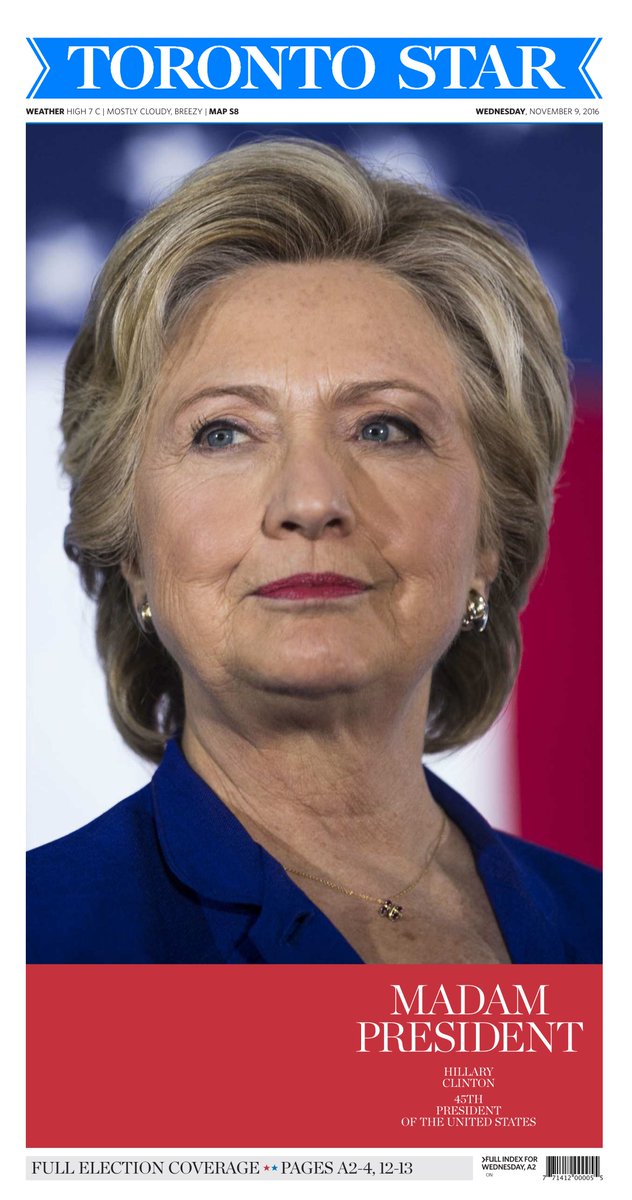I took a break from existential dread to dive into the archives and see how the @TorontoStar covered past U.S. presidential elections. The front pages have changed a little over the past 124 years ... 





1896: “A Mountainous Majority for McKinley," proclaims what was then the Evening Star, founded four years earlier by printers on strike from another paper. “Silverites” in the headline is a reference to the monetary debate that dominated the campaign. The paper cost one cent.
1900: “McKinley Stays in White House,” but bigger news is the Canadian election that took place a day later, giving Laurier’s Liberals another majority. The Evening Star is now the Toronto Daily Star (the name it would have until 1971), under the editorship of Joseph E. Atkinson.
1904: The only presidential election I found that didn’t make the Star’s front page — just a narrow column on page 2 (next to news of an overcoat thief) to mark the victory of Theodore Roosevelt, who had become president after McKinley’s assassination three years earlier.
1908: A third election loss for William Jennings Bryan, this time to Roosevelt’s hand-picked successor, William Howard Taft, who has electoral college votes to spare. Again, local news takes precedence: church may become a synagogue; girl faints when sentenced for shoplifting.
1912: Big win for Democrats, as Woodrow Wilson beats both the incumbent Taft and ex-president Roosevelt (now leading a third party). And the Star wins a “race against time” to get its photo of Wilson onto the next day’s front page. Wilson’s daughters are “tennis experts.”
1916: A day after the vote, it’s too close to call, but it still gets the biggest headline — above news from the Great War, which the U.S. has yet to enter. Two days later, Wilson’s a winner, but “If California Is Split He Will Need New Mexico to Make Him Feel Real Sure.”
1920: Landslide for Warren Harding, whose majority of “six millions” sets a record. Also in the news: Prohibition laws and hydro prices. A copy of the Toronto Daily Star will set you back two cents now.
1924: Calvin Coolidge triumphs in a three-party race. Also, news from the British Empire Exhibition at Wembley and, specifically, questions about what will happen to all the butter that was used in a sculpture of the Prince of Wales.
1928: The winner, Hoover, plans to “sit tight” in California and be a “silent” president (what a concept) until his inauguration. Lady Astor hopes Hoover will make “New York drier.” Meanwhile in Canada: tourism is up and the national debt is down. The ’20s are still roaring.
1932: Franklin D. Roosevelt’s win ushers in a new political era. FDR and his “charming wife” (who’s not even named) get photos above the fold, but a rugby scandal scores the biggest headline. Matthew Halton and Gordon Sinclair have bylines; Santa Claus Fund makes a page 1 appeal.
1936: “Forgotten men and the common people re-elect Roosevelt,” who wins every state but Maine and Vermont. The story notes his support in the South from Black people who “voted Democratic in great numbers for the first time in history.” FDR finds time to send his love to Canada.
1940: The U.S. has not yet entered the Second World War, which dominates the headlines. FDR wins an unprecedented third term. The Star is proud that its reporter shared a meal of sausage and eggs with the president on election night in his library at Hyde Park.
1944: A nation at war once again re-elects FDR, who would die just months into his fourth term (you can watch him age in these front-page pictures). “Democrat Landslide Increases Hourly.” Truman becomes vice-president.
1948: The Star doesn’t proclaim “Dewey defeats Truman,” but it does marvel at the incumbent’s “startling upset.” Republicans were sure their man “couldn’t lose.” Look at the dejection in that AP photo: “There’s no joy in Deweyville today.”
1952: HST (that’s Harry S. Truman) congratulates his Republican successor, as Eisenhower breaks a 20-year Democratic hold on the White House, burying Adlai Stevenson “under a coast-to-coast avalanche of votes.” Pictures are getting bigger now; the paper is five cents a copy.
1956: VP and future president Nixon makes a front-page appearance as Eisenhower is re-elected, but the Suez Crisis gets top billing. Also on the page: CFL playoffs. And the Canadian government turns down a Soviet invitation to toast the Russian Revolution with vodka and caviar.
1960: “It’s Kennedy in photo finish,” as Camelot makes its debut after the “worst presidential cliff-hanger in 44 years.” John Brehl reports from Hyannis Port. Downpage: an update on the condition of Clark Gable, who would die a week later. Paper costs a whopping 10 cents now.
1964: “Goldwater the Grim” licks his wounds, the Republican challenger stunned by the scale of his loss to Lyndon Johnson. Also: Bobby Kennedy wins a Senate seat, giving him a “shove toward White House.”
1968: After a year of turmoil, it’s “Nixon by a nose.” Humphrey concedes; Nixon shakes off his “loser’s image.” WALL ST. LOVES DICK, we’re told. Also: Vatican proclaims Jackie Kennedy a sinner for remarrying. And provinces want more cash from Ottawa, which sounds familiar.
1972: After a huge re-election win, a kiss on the cheek from Pat sparks a “fleeting moment of genuine warmth” from Nixon, Bruce Garvey reports. Ottawa bureau gets reaction from Pierre Trudeau, himself narrowly re-elected days earlier. Toronto Daily Star is now the Toronto Star.
1976: “Jimmy goes home — and weeps” after beating Ford in an election haunted by “Nixon’s ghost.” “The sun is rising on a beautiful new day,” Carter says in Georgia. The Star (15 cents) is still an afternoon paper but publishes several times a day. This is the four-star edition.
1980: Reagan vows to “put America back to work,” an echo of Carter’s headline promise four years earlier. Photos tell the story here. GOP wins Senate for first time in a generation. Paper is 25 cents (blame inflation). Maybe my least favourite version of the Star nameplate.
1984: An even bigger landslide for Reagan, who loses only one state to Walter Mondale. Election takes second billing to verdict in Colin Thatcher murder trial. Ben Wicks cartoon references Geraldine Ferraro, the first woman nominated for vice-president on a major party ticket.
1988: Canada’s concerns include free trade and acid rain as George H.W. Bush defeats Michael Dukakis, pledging to heal the wounds of one of the “most vicious presidential campaigns in American history,” Bob Hepburn reports. Top throw marvels at a “fingerprint computer.”
1992: Americans have “pinned their hopes on a new generation,” Linda Diebel writes, while Richard Gwyn sees a “political revolution” in Bill Clinton’s centrist approach. The Jays just won the World Series and the Star (with a 100th-birthday banner) costs 40 cents, including GST.
1996: “Clinton sails to easy win,” but he’ll face opposition — and ongoing investigations — from a GOP-controlled Congress, Carol Goar notes. Allan Thompson’s report on Zaire’s civil war also goes above the fold. Below the nameplate: an early web address for the Star.
2000: “It’s President Bush” — or is it? After a “long roller-coaster of a night,” George W. Bush is declared the victor, Kathleen Kenna reports. But the next day’s paper leads on a recount in Florida, with a post-mortem on how TV networks twice “botched” the winning call ...
2000 (cont’d): The Star was one of many papers that had followed the networks’ lead, declaring victory for Bush in its late editions. The recount saga stretches on for weeks, until Dec. 13, when “Gore bows to Bush” after a Supreme Court decision.
2004: “Four more years” for Bush, who vows to “reach across the partisan divide and begin healing a polarized nation,” Tim Harper reports. Left-leaning Americans look longingly at Canada. Also: the Liberal sponsorship scandal, and The O.C.’s season premiere. Paper is 50 cents.
2008: “A dream fulfilled.” Election of Barack Obama raises hopes for a “new, post-racial era,” Tim Harper writes. Royson James reports from Selma, Ala., where a 79-year-old voter tells him: “I never thought I would see the day.”
2012: Democrats hold the White House in a “whisker-thin triumph for Obama and a crushing defeat for Romney,” Mitch Potter writes. Robert Benzie reports from Chicago, where young voters cheer Obama’s win. The paper that once cost a cent now costs a dollar — still a good deal.
2016: “America on the edge,” as Trump “closes in on the presidency” (the definitive call came too late for print deadlines). Daniel Dale writes that Americans “appeared poised to give immense power to an erratic, never-elected and habitually untruthful candidate ...
2016 (cont’d) “... whose behaviour and policy positions have alarmed much of the world — and who would face no organized opposition in Congress.” Rosie DiManno: “America is angry, seething with bitterness and bile. America is maddened. America should be ashamed of itself.”

 Read on Twitter
Read on Twitter